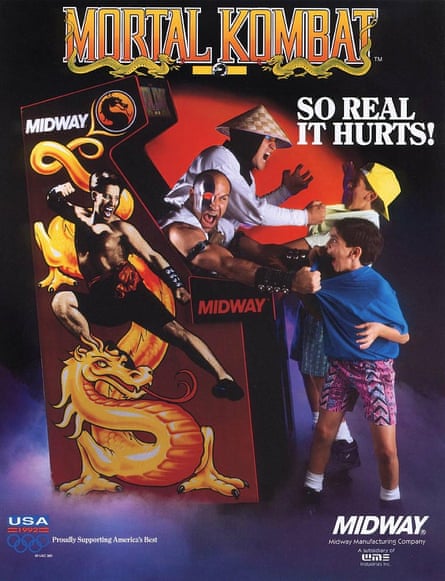On 9 December 1993, Democratic senator Joe Lieberman sat before a congressional hearing on video game violence and told attendees that the video game industry had crossed a line. The focus of his ire was Mortal Kombat, Midway’s bloody fighting game, recently released on the Sega Genesis and Super Nintendo Entertainment System after a successful run in the arcades. “Blood splatters from the contestants’ heads,” he told the room. “The game narrator instructs the player to finish his opponent. That player may choose a method of murder ranging from ripping a heart out or pulling off the head of the opponent, with spinal cord attached.”
Lieberman’s aim with the congressional hearing had been to force the US games industry into creating a formal ratings system, preventing minors from buying violent titles. He succeeded in that – the Entertainment Software Rating Board was established as a result of the hearing – but he also boosted a moral panic that had quietly begun with the launch of the Mortal Kombat arcade game in 1992. This then took on more urgency following the high-profile home console release on 13 September 1993 – a global simultaneous launch Midway named Mortal Monday. US news networks were sending reporters to arcades, interrogating teens as they enthusiastically dismembered each other’s fighters. Newspapers were interviewing alarmed child psychologists. The BBC responded by featuring the game on its late-night news magazine programme The Late Show, calling in author Will Self to play live in the studio.

It’s interesting now to watch those hearings and then look at the game they were describing. Released this week, Mortal Kombat: Legacy Kollection is an anthology of the first four titles in the series, in arcade and various home console forms, as well as an array of spin-offs for the Game Boy Advance and PlayStation. The original titles are almost quaint relics of 1990s teen culture. The digitised visuals, created by filming actors performing martial arts moves then converting that footage into 2D sprite animations, are charmingly jerky and low-resolution, the controversial fatalities more bloodily amusing than horrifying. Brilliantly, the Kollection comes with a Fatality Trainer allowing you to easily access and practise the viscera-splattered death moves from each title. If this mode had been available at the time, it’s probably the only thing I’d have played.
Playing again now, the game is obviously a product of twenty-something guys brought up on 80s horror films. Midway had originally assembled a four-man team including coder Ed Boon and John Tobias to produce a combat action game starring Jean-Claude Van Damme. However, when that deal fell through, Boon and Tobias imagined a competitor to hugely successful Capcom hit Street Fighter II, inspired by the wave of popular hyperviolent martial arts flicks such as Bloodsport and Best of the Best. Boon’s elevator pitch was “the MTV version of Street Fighter”, and the fatalities emerged throughout the development process, the team pulling in ideas from their favourite movies: RoboCop, Terminator and Enter the Dragon. Straight away, the company knew that blood and guts would mean notoriety and no one was fazed. Talking to Polygon in 2022, Boon said, “If there was something that we would even say, ‘Is this going too far?’ our CEO was like, ‘No, go even further.’ Plus we had [Midway game designer] Eugene Jarvis as our mentor […] he had just done Narc, which was a pretty violent game in its own right. So if anything, we were encouraged to go even further.”
In effect, the moral panic over Mortal Kombat was to the early 1990s what the video nasty controversy was to the early 1980s. It was about the fear of new entertainment technologies entering family homes unchecked and poisoning the minds of children. It also ensured the success of the series. Mortal Kombat became the biggest-selling game of the Christmas season and beyond, shifting six million copies across multiple machines. What the Kollection shows is how adaptable the games have been, taking the original arcade concept on to handheld platforms and then into the 32-bit console era where spin-offs Mortal Kombat Mythologies: Sub-Zero and Mortal Kombat: Special Forces expanded into the action-adventure genre.
For the industry itself, the Mortal Kombat panic simply became a new front on which to fight the console wars. Sega courted the controversy, allowing Mega Drive owners to access the full gore of the arcade version by inputting a “secret” code. By contrast, Nintendo sought to bolster its family-friendly image by removing fatalities and turning the game’s blood into grey “sweat”. Unsurprisingly, it was the Sega version that sold best.

There have been many media panics since this one. Doom remained a tabloid fixture for the entire 1990s, becoming inextricably linked with the Columbine school shooting due to Eric Harris and Dylan Klebold’s interest in the game. Grand Theft Auto and Call of Duty were regular targets throughout the 2010s, and more recently Fortnite has been accused of leading a generation of schoolchildren into addiction. But the sight of Joe Lieberman in that wood-panelled senate room describing gruesome images from Mortal Kombat – as well as Night Trap and Lethal Enforcers – retains its unique fascination.
This was a turning point for the games business – it was the era in which the focus shifted from children to teens, from abstract puzzlers and platformers to graphically rich shooters, bloody fighting games and adult-oriented action adventures. Midway set out to discover exactly what it could get away with. The answer shaped the entire industry.

 8 hours ago
8
8 hours ago
8

















































